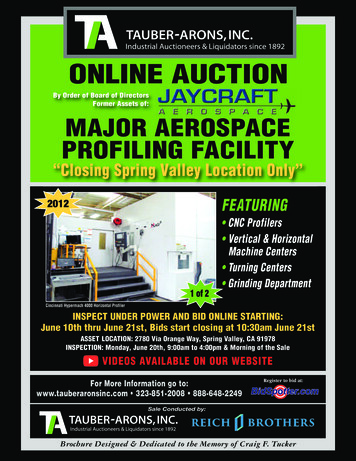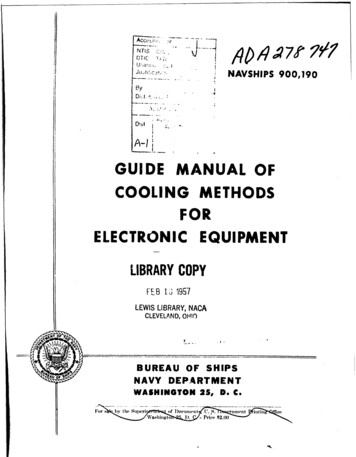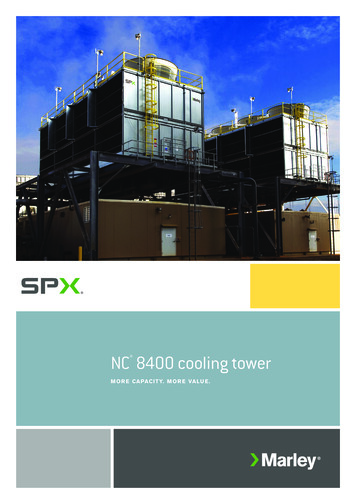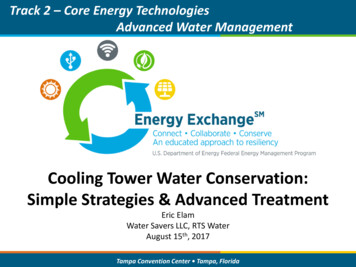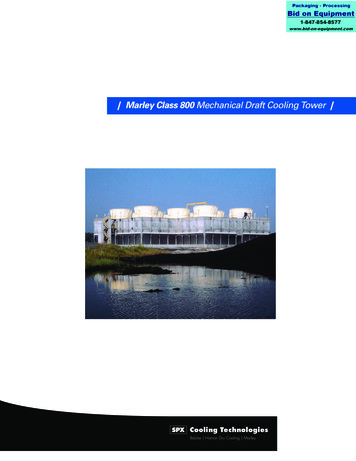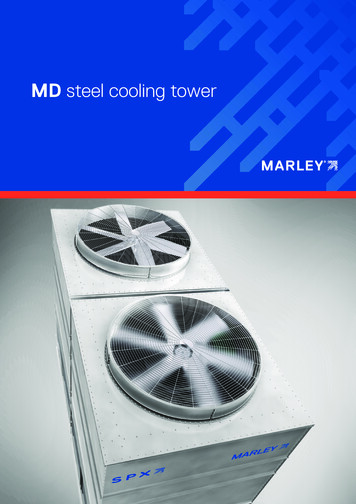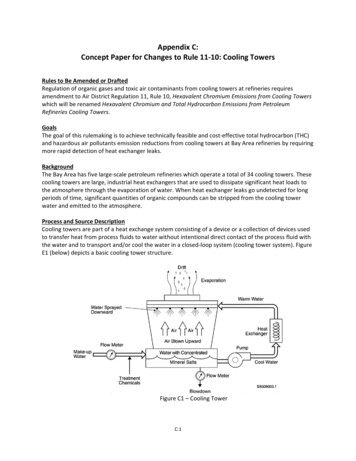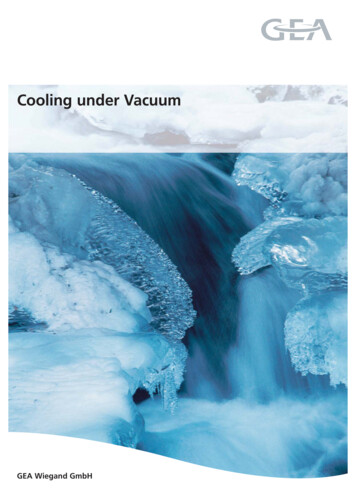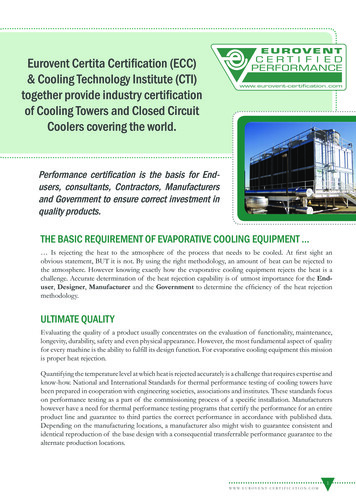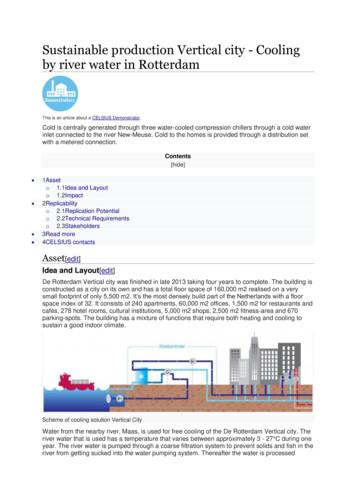
Transcription
Sustainable production Vertical city - Coolingby river water in RotterdamThis is an article about a CELSIUS Demonstrator.Cold is centrally generated through three water-cooled compression chillers through a cold waterinlet connected to the river New-Meuse. Cold to the homes is provided through a distribution setwith a metered connection.Contents[hide] 1Asseto 1.1Idea and Layouto 1.2Impact2Replicabilityo 2.1Replication Potentialo 2.2Technical Requirementso 2.3Stakeholders3Read more4CELSIUS contactsAsset[edit]Idea and Layout[edit]De Rotterdam Vertical city was finished in late 2013 taking four years to complete. The building isconstructed as a city on its own and has a total floor space of 160,000 m2 realised on a verysmall footprint of only 5,500 m2. It’s the most densely build part of the Netherlands with a floorspace index of 32. It consists of 240 apartments, 60,000 m2 offices, 1,500 m2 for restaurants andcafés, 278 hotel rooms, cultural institutions, 5,000 m2 shops, 2,500 m2 fitness-area and 670parking-spots. The building has a mixture of functions that require both heating and cooling tosustain a good indoor climate.Scheme of cooling solution Vertical CityWater from the nearby river, Maas, is used for free cooling of the De Rotterdam Vertical city. Theriver water that is used has a temperature that varies between approximately 3 - 27 C during oneyear. The river water is pumped through a coarse filtration system to prevent solids and fish in theriver from getting sucked into the water pumping system. Thereafter the water is processed
through an antifouling system that uses chlorine as the antifouling agent. The water continuesthrough a second stage of filters before passing through a heat exchanger. Problems during theearly stage of the project occurred with small organisms, such as clams, that passed through thefilter system. When settled, the organisms grew causing problems in the system. Anenvironmental friendly extra anti-fouling step is used to solve this: thermic shocks. This method isused to prevent small organisms and clams from growing inside the system. The small eggs ofthe clams can pass the filtering system and stay inside the heat exchanger system. Whengrowing they obstruct the flow in the system. By periodically raising the temperature to a highdegree in a short term, called thermic shock, the clams and other small organisms are unable tohold their grip on the inner surface of the system and are flushed out.The system is also connected to electrically driven water cooled screw compressor chillers usedwhen the river water temperature is too warm and supplementary cooling is needed. The riverwater chills the cooling medium that passes through the chillers which in its turn chills the waterthat is distributed to the buildings. The buildings are then cooled by different heat exchangesystems that cool the air. The river water is returned to the river after passing through the chillersand heat exchanger. The water supplied to the building has a temperature of approximately 812 C while the returning warmed water has a temperature of approximately 16 C.Impact[edit]Masterplan cooling around Vertical City (aka De Rotterdam)When the river temperature is below 9 C the buildings are cooled with free cooling only. Whenthe river temperatures vary between 9-15 C a combination of free cooling supplemented withchillers are used while when the river temperature reaches above 15 C only chillers are used tocover the cooling demand of the buildings. In accordance to the energy company, Eneco, thecoefficient of performance, COP, varies from a COP of 5 when only the chillers are used and canreach up to a COP of 40 when only free cooling is used.In the basement of Vertical City a large space is reserved to have large compression chillers anda bigger Cooling from river water network. All new buildings close to Vertical City will beconnected to that. The overall demonstrator’s performance is summarized in the following tableaccording to 5 evaluation criterions. It can be noticed that the assignment of all the scores isdirectly linked to the values calculated for the Key Performance Indicators, except for socio-
economic benefits where a qualitative assessment is carried out based on this cluster’s indicatorsand on separate interviews.Overall ImpactFair/MediumSize [MWh/y]1-100Primary Energy Savings0-10% 10-20%20-40%40-60% 60%GHG Emissions Reduction0-10% 10-30%30-60%60-90% 90%Pollutant Emissions Reduction 0-10% 10-30%30-60%60-90% 90%Socio-Economic BenefitsMediumHighExtremLow100-1000 1000-5000 5000-10000 10000FairReplicability[edit]Replication Potential[edit]ReplicabilityAuthorizative easinessLow Medium HighxAdaptability to different climate conditionsxTechnology easy-to-implement (No needs of specific technical requirements)xEasy-to-implement (No needs of specific technical requirements)xEasy-to-operate (No needs of specific technical requirements)xOpportunity of integrating waste energy sourcesCAPEX needed for the deployment of the solutionTechnical Requirements[edit]xx
Important, of course, is that water is available close to the building. Since the water temperatureis not very high, longer distances can be used because the thermal losses will still be small. Readmore in the Technical ameOrganizationTypeOrganization DomainBenefits from demoDeveloperMAB/OVGdevelopmentPrivatecompanyReal estate developmentFulfil the highambition wishes ofpotential clientsDesignerOMAPrivatecompanyArchitectureFulfil the wishes ofthe customer, iconicbuildingEngineeringcooling systemEnecoEnergycompanyEnergyImplementinnovative energysolutions and goodshowcaseLocalgovernmentCity ofRotterdamMunicipalityCity development,environmentalissues/regulationsGood showcase andmore sustainableenergy supplyRead more[edit]Introduction to District Energy Cooling from excess energyTechnical Toolbox River water cooling technologyCase studies Cooling from river water in GothenburgDistrict cooling in Helsingborg, Sweden - a ReUseHeat exampleCELSIUS City Supporters RESCUE ProjectCELSIUS contacts[edit]
CELSIUS partners contributing to this article: City of RotterdamFor further engagement on this subject you are welcome to turn to your CELSIUS city contactperson or use the contact form for guidance to relevant workshops, site visits or the expert team.Categories: Rotterdam CELSIUS Demonstrators Cooling Production Renewable energy
De Rotterdam Vertical city was finished in late 2013 taking four years to complete. The building is . The building has a mixture of functions that require both heating and cooling to sustain a good indoor climate. Scheme of cooling solution Vertical City Water from the nearby river, Maas, is used for free cooling of the De Rotterdam Vertical .
